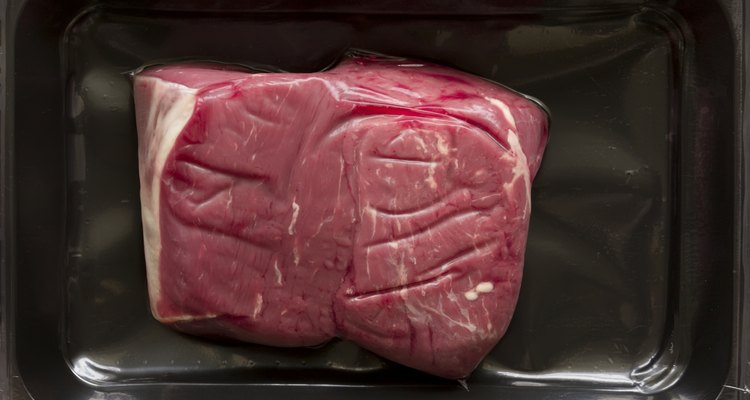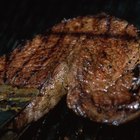
humbak/iStock/Getty Images
Whether you're experiencing prosperous or rough economic times, buying meat when it's on sale and vacuum-sealing it or ordering prefrozen vacuum-sealed meat from a vendor may save you money. Unless the steak is very thin, it must be thawed safely before cooking, or the outside will be browned or burned before the inside of the meat is completely thawed. Because vacuum-sealing preserves the flavor of the meat and juices and isn't as prone to taking on a "freezer-burned" taste, a little care in preparation will garner you fresh-tasting meat.
Thaw, then Broil
Thaw meat in the refrigerator. The USDA recommends that meat be thawed slowly in the refrigerator and not at room temperature. Thawing in this way allows for a juicier and more flavorful steak, as well as preventing potential bacteria from forming, as can happen if you thaw meat at room temperature.
Place meat in the refrigerator on the day prior to cooking, or allow for about three to seven hours per pound of meat, depending on the thickness of the cut. Once the meat is thawed, remove it from the packaging, season it as you desire and place it on a broiler pan sprayed with the cooking spray of your choice.
Place the top rack in the oven about 5 inches from the broiler coil at the top of your oven, allowing space for the broiler pan and a steak about 1 inch thick. For thicker steaks, adjust the top rack slightly lower. Slide the steak and the broiler pan into the oven -- your steak should be 1 1/2 to 2 inches below the heat coil of the broiler. Leave the oven door a few inches open while broiling.
Turn the steaks over after one to three minutes, depending on how well you want the meat cooked, and return them to the broiler. Cook another one to three minutes under the broiler, remove the steaks and serve them immediately. If you are broiling a thicker steak or tenderloin that has been thawed, let the meat rest for about five to 10 minutes before serving, so the juices don't drain away when you're slicing it.
Thaw, then Grill
Thaw steaks slowly in the refrigerator. If you must thaw the steaks more quickly in the microwave oven, leave them in the vacuum seal and use the defrost setting, following the appliance instructions for thawing the steaks. This is not the best recommended thawing method, as the microwaving can dry out meat and reduce flavor.
Remove the steaks from their vacuum seals and season them as you desire. Whether your grill is charcoal or gas, preheat it according to the manufacturer's instructions before placing the steaks on the grill.
Place steaks on the grill. If you prefer your steaks well-done, place them over the hotter portion of the grill, usually in a center area. For those who prefer their meat with more rare centers, place the steaks on the outer edges of the central heat area so they don't cook as quickly as the other steaks.
Turn the steaks over after three to five minutes, depending on how well you want them cooked, and continue searing them on the grill. Remove the steaks from the grill when they are as done as you desire and serve them immediately.
Related Articles
How Long Can Steak Stay Good While ...

Rules for Thawing and Refreezing Meat

What Happens if Meat Unfreezes and Then ...

Is Frozen Ground Beef Left out for 3 ...

How to Defrost a Steak and Keep It ...

How Long Can Meat Stay out of the ...

How to Cook a Thin Cut New York Steak

How Long Can Raw Meat Sit Out?
Can You Freeze Shish Kabobs?
How Long Should I Keep Steaks ...

How to Cook Beef Tenderloin on a ...

How Long Can You Leave Frozen Meat Out?
Does Filet Mignon Freeze Well?

Can You Freeze Leftover Dough From a ...

Can I Marinate Steak Then Freeze It?

How to Cook a Frozen Beef Patty ...

How to Cook a Tender Porterhouse Steak ...

How to Bake Frozen Spanakopita

Grilling Instructions for Rib-Eye Steak

How to Cook a Steak After Using a ...
References
Warnings
- Per the USDA, meat should be properly frozen to store it or cooked and served by the packaging sell-by date. This date is not an expiration date, but the date set to warn the user -- and grocer -- that after this date, food will begin to deteriorate more quickly.
Writer Bio
Kristen Douglas has been writing since 1984 and editing since 1996. She has contributed to "Independent News," "Folio Weekly" and numerous private blogs, with experience covering topics such as home and garden, education, marketing, mental health and cooking/food. Douglas has certification in information processing from Metro Business College and a Bachelor of Arts in psychology from Columbia College.
Photo Credits
humbak/iStock/Getty Images